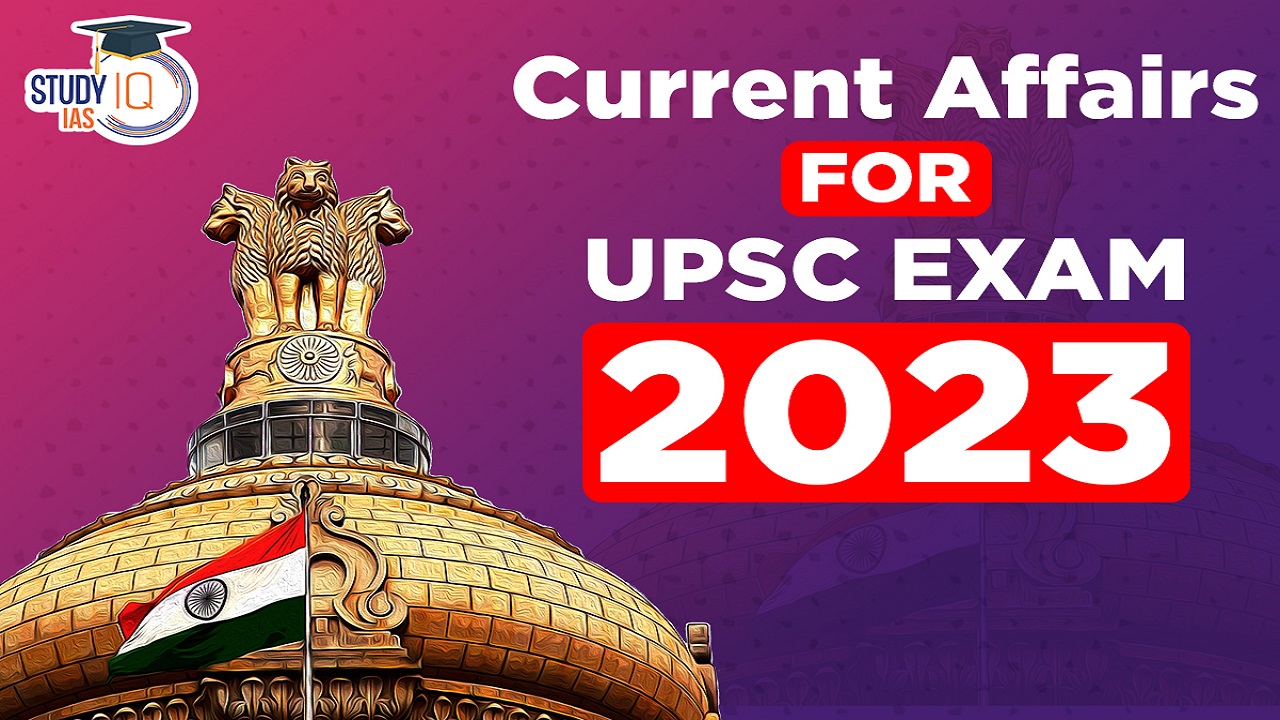Table of Contents
Current Affairs 8th May 2023 for UPSC Prelims Exam
Atmospheric Dust
Context: A new research has found that nutrients derived from atmospheric dust deposited on an ocean’s surface play a key role in mediating global phytoplankton biomass distributions.
What is Atmospheric Dust?
- Atmospheric dust, also known as mineral dust, is a type of aerosol consisting of small particles of dust and other matter, such as soil, pollen, volcanic ash etc. that can be suspended in the air.
- It can originate from both natural sources such as deserts, wildfires, and volcanic eruptions, as well as human activities such as agriculture, construction, and industry.

How atmospheric dust affects climate and life on earth?
- It can reflect and absorb incoming solar radiation, which can lead to cooling or warming of the atmosphere depending on its composition and location.
- Dust particles can act as condensation nuclei for water vapour, leading to cloud formation and affecting precipitation patterns.
- Dust can also have a direct impact on human health, particularly for those with respiratory conditions and can have negative impacts on agriculture and air quality.
- Large-scale dust events, such as those associated with desertification, can have significant ecological impacts, leading to soil degradation and loss of biodiversity.
- Atmospheric dust plays a role in the Earth’s radiation budget, both by scattering and absorbing incoming solar radiation, and by reflecting outgoing terrestrial radiation back to the surface.
- Atmospheric dust can also influence biogeochemical cycles, such as the cycling of carbon and nutrients through ecosystems.
- For example, dust particles can serve as a source of nutrients for ocean ecosystems, and can even help stimulate the growth of phytoplankton, which are important primary producers in marine food webs.
Current Affairs 6th May 2023 for UPSC Prelims Exam
Black Sea Grain Initiative
Context: United Nation is working toward the extension of the Black Sea Grain Initiative, and asks all parties concerned to engage constructively.
About Black Sea Grain Initiative
- Background: Ukraine exports around 45 million tonnes of grain to the global market each year.
- After the Russian invasion, Ukraine was left with large amount of grains stored in silos unable to be transported to other parts of the world. This has affected the global supply of food grains.
- Launch: The Initiative on the Safe Transportation of Grain and Foodstuffs from Ukrainian ports, also called the Black Sea Grain Initiative, was an agreement between Russia and Ukraine with Turkey and the United Nations (UN) made during the 2022 Russian invasion of Ukraine.
- It was signed separately by Russia and Ukraine in Istanbul with Turkey and the United Nations on July 22, 2022.
- The deal, initially in effect for 120 days, was extended in mid-November 2022 for another 120 days till March 18, 2023.
- At that point, Russia only agreed to extend the deal for a further 60 days, till May 18.
- Signatories: Ukraine, Russia, Turkey, and United Nations.
- Objectives:
- It sought to create a safe passage of food grains exported from Ukraine.
- Under this agreement, export of grain, food and fertilizers will be allowed to resume from Ukraine via a “safe maritime humanitarian corridor” from three key Ukrainian ports i.e., Chornomorsk, Odesa, and Yuzhny/Pivdennyi.
- Implementation: A Joint Coordination Centre (JCC) having representatives from signatories of the Black Sea Grain Initiative was set up to implement this deal.
- The JCC is tasked with registering and monitoring the departure of commercial ships via satellite, internet, and other communication means.
- Its primary responsibility is to check for the absence of unauthorized cargo and personnel on board of the vessels.
- The JCC is located on the campus of the National Defense University, near Istanbul. The center is headed by a Turkish admiral.

ISRO START
Context: Recently, Indian Space Research Organisation (ISRO) has announced a new introductory-level online training programme called Space Science And Technology Awareness Training (START).
About START
- Mission: To provide students with introductory-level training in space science and technology, giving them an overview of different facets of the field, research opportunities, and career options.
- It emphasizes on cross-disciplinary nature of space science, giving students insights into how their individual aptitudes can be applied to the field.
- Eligibility: Postgraduate and final-year undergraduate students of physical sciences and technology.
- It will cover various domains of space science, including astronomy and astrophysics, heliophysics and sun-earth interaction, instrumentation and aeronomy.
- It will be delivered by scientists from Indian academia and ISRO centres.
Significance
- It is part of ISRO’s efforts to enable Indian students to become professionals in space science and technology, as the organization’s space science exploration program continues to expand into new domains.
- Student community will be benefited from this training programme, as they will receive an overview of the different facets of space science and technology, exposure to the research ongoing in different Indian institutes, insight into how their individual aptitude would suit some of the facets of space science and technology, appreciate the cross-disciplinary nature of the subject, and accordingly choose their career path.
Diabetes Mellitus
Context: According to recently published study, early diagnosis and treatment of gestational diabetes mellitus results in additional protection for babies and mothers from pregnancy complications.
About Diabetes Mellitus
- Diabetes mellitus is a disorder in which the body does not produce enough or respond normally to insulin, causing blood sugar (glucose) levels to be abnormally high.
- Impact of Diabetes mellitus
- Urination and thirst are increased, and people may lose weight even if they are not trying to.
- Diabetes damages the nerves and causes problems with the sense of touch.
- Diabetes damages blood vessels and increases the risk of heart attack, stroke, chronic kidney disease, and vision loss.
Diabetes
- It is a condition that happens when blood sugar (glucose) is too high.
- It develops when pancreas doesn’t make enough insulin or any at all, or when your body isn’t responding to the effects of insulin properly.
- Diabetes insipidus is a relatively rare disorder that does not affect blood glucose levels but, just like diabetes mellitus, causes increased urination.

Molecular Motors
Context: An international team of researchers, including from the National Centre for Biological Sciences (NCBS), Bengaluru, has reported a new kind of molecular motor.
About Molecular Motors
- Molecular motors are a class of proteins that drive intracellular trafficking by converting chemical energy to mechanical work along cytoskeletal filaments.
- They are directed movement along cytoskeletal filaments.
- Eukaryotic cells contain motors that help to transport organelles to their correct cellular locations and to establish and alter cellular morphology during cell locomotion and division.
- They differ in the type of filament they bind to (either actin or microtubules), the direction in which they move along the filament, and the “cargo” they carry.
- Many motor proteins carry membrane-enclosed organelles, such as mitochondria, Golgi stacks, or secretory vesicles (eg hormones or neurotransmitters), to their appropriate locations in the cell.
- Other motor proteins cause cytoskeletal filaments to slide against each other, generating the force that drives such phenomena as muscle contraction, ciliary beating, and cell division (mitosis).
- Motor proteins use the energy of ATP hydrolysis to move along microtubules or actin filaments.
- They mediate the sliding of filaments relative to one another and the transport of membrane-enclosed organelles along filament tracks.
Significance of Study
- The discovery of the molecular motor could have potential applications in biology and medicine.
- The study provides a general mechanism that is applicable to many mechanochemical proteins or assemblies that harness chemical energy for mechanical work in cells.

Article 355 of the Indian Constitution
Context: In a response to the recent ethnic violence that has engulfed Manipur, the central government has invoked article 355 of the constitution to tackle the security situation in the state.
What is Article 355?
- Article 355 is found in part XVIII of the Indian constitution which contains emergency provisions that are meant to be used in extremely rare circumstances.
- It places a duty on the Union government to safeguard every state against external threats, such as military attacks from other countries, and internal disturbances, such as civil unrest or rebellion.
Historical Background of Article 355
- Article 355, as it currently exists, was not in the 1948 draft constitution, and was only added in September 1949 (as draft Article 277A).
- It was inserted with the objective of providing a legitimate ground for the application of Article 356 of the constitution, which allows the Union government to issue a proclamation of President’s Rule in a specific state.
Powers granted to the Union government under Article 355
- Article 355 of the Indian Constitution grants the Union government the power to protect every state against external aggression and internal disturbance and to ensure that the government of every state is carried on in accordance with the provisions of the Constitution.
- This includes the power to intervene in the internal affairs of a state in certain circumstances to maintain peace and order, and to ensure that the constitutional rights of citizens are protected.
Additional Powers to the Union under Article 355
Article 355 of the Indian Constitution not only gives the Union government the power to monitor the administration of the states but also several additional powers such as:
- Power to Pass Laws on the Matters Mentioned in the State List: The Indian Constitution gives the Union government the power to pass legislation on any matter listed in the State List of the 7th Schedule if it deems it necessary for the interest of the nation.
- Power to Enforce Laws for Defence and Armed Forces: The central government has the authority to pass laws regarding the deployment and maintenance of armed troops in a state to assist the civil power, as outlined in Entry 2A of the Union List of the 7th Schedule.
- Financial Support to the States: As per Article 275 of the Indian Constitution, the Parliament has the authority to provide financial assistance to states that it deems in need. The power given to the Union under Article 275 is consistent with Article 355 of the Indian Constitution.
Duration of restriction
- The duration of the assistance provided under Article 355 is not specified in the Constitution.
- The Union government can withdraw its assistance when the situation is normalized or when the state government requests it to do so.
- The duration of the assistance provided under Article 355 is subject to judicial review and can be challenged in court if it violates any fundamental rights or constitutional provisions.
Reasonable restrictions
- The President cannot use this article on his/her own initiative; it must be done on the advice of the Union Council of Ministers.
- The use of Article 355 does not authorize the President to intervene directly in the affairs of the state.
- The President can use this article only to give directions to the state government, and not to the state legislature or the judiciary.
- The use of Article 355 should be limited in duration and scope and should not result in the permanent erosion of the state’s autonomy or the violation of its constitutional rights.
Related Information: Emergency Provisions: Types of Emergency
| Basis of Classification | National Emergency | Constitutional Emergency | Financial Emergency |
| Grounds of Declaration | War, external aggression.
Armed rebellion |
Failure of constitutional machinery.
Also known as President’s Rule |
Financial instability |
| Parliamentary Approval | Approval by both the houses by special majority within 1 month of issue of proclamation. | Approval by both the houses by special majority within 2 months of issue of proclamation. | Approval by both the houses by special majority within 2 months of issue of proclamation. |
| Revocation of Proclamation | By the President.
By resolution of Lok Sabha. |
By the President. | By the President. |
| Implementation | It has been invoked three times in India during 1962, 1971 and 1975. | President’s Rule has been invoked more than 115 times in India. | Not Yet Invoked |
| Judicial review | Allowed | Allowed | Allowed |
| Article | Article 352 | Article 356 | Article 360 |
Arab League
Context: The Arab League has re-admitted Syria into the grouping after a decade-long suspension.
About Arab League
- Arab League is a regional group of Arab countries, spanning over Middle-East, North Africa, western and Eastern Africa.
- Origin: The group was formed in 1945 in Cairo, with Egypt, Iraq, Jordan, Lebanon, Saudi Arabia, and Syria as founding members.
- Currently, it has 22 members. The Charter of the Arab League, also known as the Pact of the League of Arab States, is the founding treaty of the organisation.
- Observers include Brazil, India, Eritrea and Venezuela.
- Objective: Maintaining closer the relations between member states and collaborate with them, to safeguard their independence and sovereignty, and act in a way to uphold the interests of the Arab countries.
- Structure:
- The League consists of the Council, the Special Ministerial Committees, the General-Secretariat and the Specialised Agencies.
- The Council acts as the principal political organ. It consists of foreign ministers of all the member-countries. Every member country has one vote on the Council, and decisions are binding only on those states that have voted for them.
- The Special Committees draw up common policies for the regulation and advancement of cooperation in their respective fields (information, internal affairs, justice, housing, transport etc).
- The General-Secretariat is headed by a Secretary-General elected by the Council for a five-year term. It is responsible for executing the decisions of the Council and responsible for internal administration.
- India and Arab League:
- India was given the observer status in 2007, despite it not having an Arabic-speaking population.
- India has good trade relations with the Arab world. It also has a large diaspora in the Arab League countries.

Criteria for Scheduled Caste (SC) Status
Context: The Inquiry Commission, led by the Former Chief Justice, is currently examining whether Dalit individuals who convert to religions other than Sikhism or Buddhism should be granted Scheduled Caste status.
About Criteria for Scheduled Caste Status:
- Scheduled castes are sub-communities within the framework of the Hindu caste system who have historically faced deprivation, oppression, and extreme social isolation in India on account of their perceived ‘low status’.
- Only marginalised Hindu communities can be deemed Scheduled Castes in India, according to the Constitution (Scheduled Castes) Order, 1950.
- The criterion for SC status is determined by the Constitution of India and is based on social, educational, and economic indicators.
- According to the Indian Constitution, a community can be classified as an SC if it meets the following criteria:
- The community is considered to be “untouchable” or “Dalit” and has faced discrimination for centuries.
- The community has a low social status, as determined by traditional caste-based occupations such as manual scavenging, leather work, or tanning.
- The community has poor educational and economic indicators, as measured by factors such as literacy rates, poverty levels, and access to basic amenities.
Background
- The Constitution (Scheduled Castes) Order of 1950 initially provided for recognising only Hindus as SCs, to address the social disability arising out of the ‘practice of untouchability’.
- On the recommendations of Kaka Kalelkar Commission 1955; the Order was amended in 1956 to include Dalits who had converted to ‘Sikhism’ and once more in 1990 to include Dalits who had converted to ‘Buddhism’.
- The Union government in 2019 rejected the possibility of including Dalit Christians as members of SCs, rooting the exclusion on an Imperial Order of 1936 of the then colonial government, which had first classified a list of the Depressed Classes and specifically excluded “Indian Christians” from it.
Schedule caste status in India
- The term “Scheduled Castes” has been defined in Article 366(24) as such the castes, races or tribes or parts of groups which are deemed under Article 341 to be scheduled castes for the purposes of this Constitution.
- Article 341(1) of the Indian Constitution gives power to the president to notify which castes in the country and in specific states come under the category of Scheduled Castes.
- Under article 341 (2) of the Constitution the power to make changes to the SC and ST list lies with the Parliament and not state legislatures. Any change in the lists of the Scheduled Castes and Tribes requires a constitutional amendment.
- Only proposals agreed upon by both the Registrar General of India and the National Commission for Scheduled Castes are introduced as a Bill in Parliament.
- However, approval from RGI has done away with the rules framed in 1999.
China-Pakistan Economic Corridor (CPEC)
Context: Pakistan and China reaffirmed their commitment to the China-Pakistan Economic Corridor (CPEC) at the Pakistan-China Strategic Dialogue, one day after India criticized the project.
What is CPEC?
- Overview: The China-Pakistan Economic Corridor (CPEC) is a bilateral project between China and Pakistan, aimed at promoting connectivity across Pakistan with a network of highways, railways, pipelines, and energy and industrial infrastructure development projects.
- It is part of China’s Belt and Road Initiative and involves the construction of a 3,000-km long route of infrastructure projects connecting China’s northwest Xinjiang Uygur Autonomous Region to the Gwadar Port in Pakistan’s western province of Balochistan.
- Projects and Financing: CPEC consists of multiple modern highway and railway projects, including the planned rebuilding and upgrading of Pakistan’s National Highway 35, also known as the Karakoram Highway or China-Pakistan Friendship Highway.
- The proposed projects in CPEC will be financed by heavily subsidized loans that will be disbursed to the Government of Pakistan by Chinese banks.
- Extension of CPEC: China and Pakistan have recently expressed their interest in inviting third party countries like Taliban led Afghanistan to join the project, despite India’s objections Analysts believe that Saudi Arabia, UAE and Germany might come on board.
India’s Reasons for Opposing CPEC: India has taken a strong stance against CPEC since its inception, and this opposition is rooted in several factors.
- Violation of India’s Territorial Claims: India considers POK as its integral part and has passed a resolution in the Parliament in 1994 stating the same. CPEC is bound to pass through Gilgit-Baltistan, which is part of the larger territorial dispute between India and Pakistan over the state of Jammu and Kashmir (J&K). The construction of CPEC in POK is a violation of India’s territorial claims and sovereignty.
- Bilateral Issue: India has always maintained that the India-Pakistan issue should be solved bilaterally, and China’s involvement in this dispute through funding CPEC is not welcomed.
- Strategic concern: CPEC’s strategic location near the mouth of the Straits of Hormuz is a concern to India as it is the route through which 63% of India’s oil imports pass. India sees CPEC as a manifestation of China’s “String of Pearls” strategy, aimed at encircling India. It gives a direct foothold to Pakistan, which India sees as a strategic threat. India is concerned about the potential to change the regional balance of power.
- Undermining Chabahar Port: The foremost concern with Afghanistan joining CPEC is that India is apprehensive of its investment in Chabahar port in Iran. India is wary of undermining the India–Iran–Afghanistan trilateral that gives Afghanistan access to sea via Chabahar port.
- Weakening of India’s Economic Influence: Attempts to extend CPEC to Afghanistan may undermine India’s position as an economic, security and strategic partner of Afghanistan.


 Personality Rights in India: Expanding P...
Personality Rights in India: Expanding P...
 Judicial Recognition of Child Traffickin...
Judicial Recognition of Child Traffickin...
 Misrepresentation and Fraud in Digital T...
Misrepresentation and Fraud in Digital T...

























